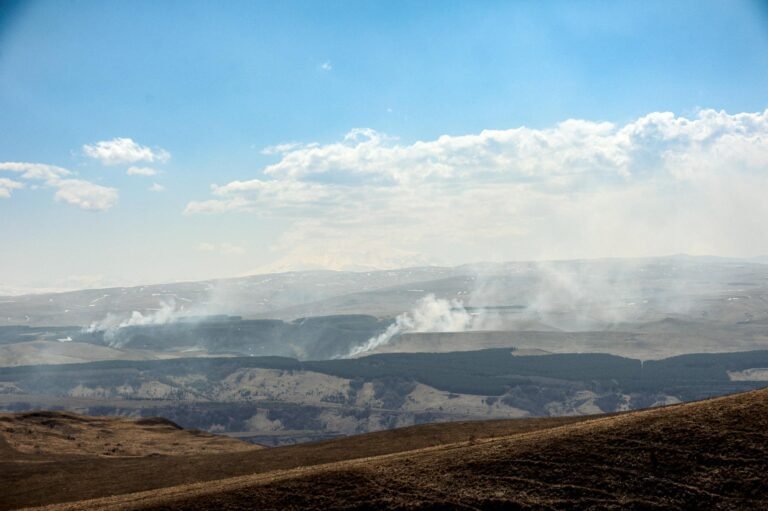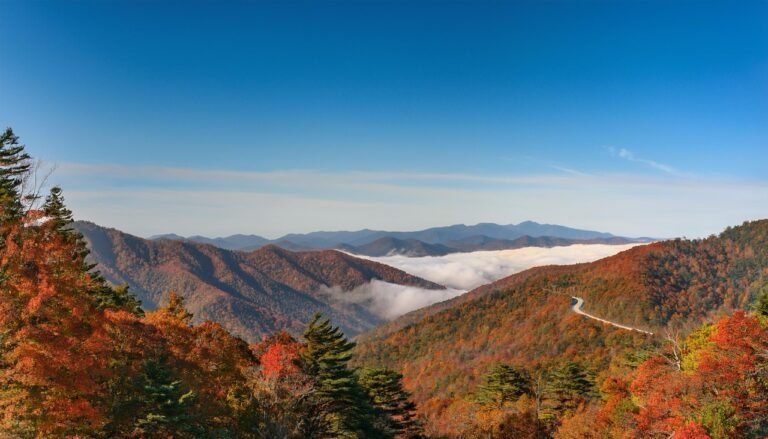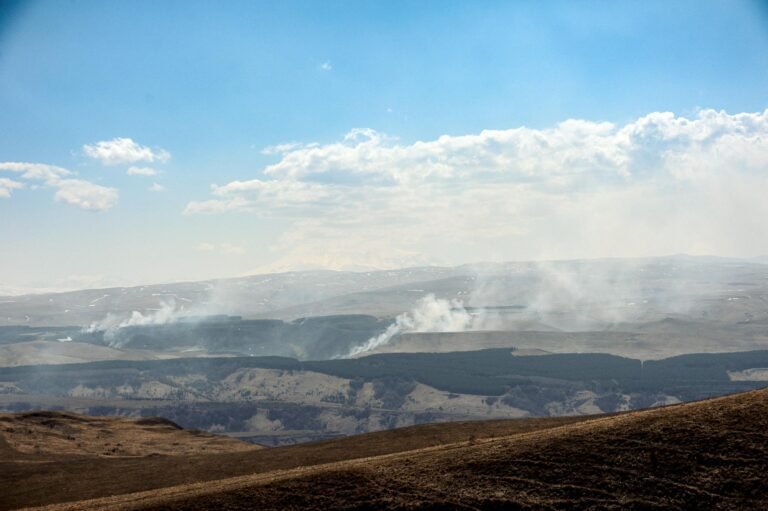Great Smoky Mountains in the Fall
Gatlinburg: Your Cozy Starting Point
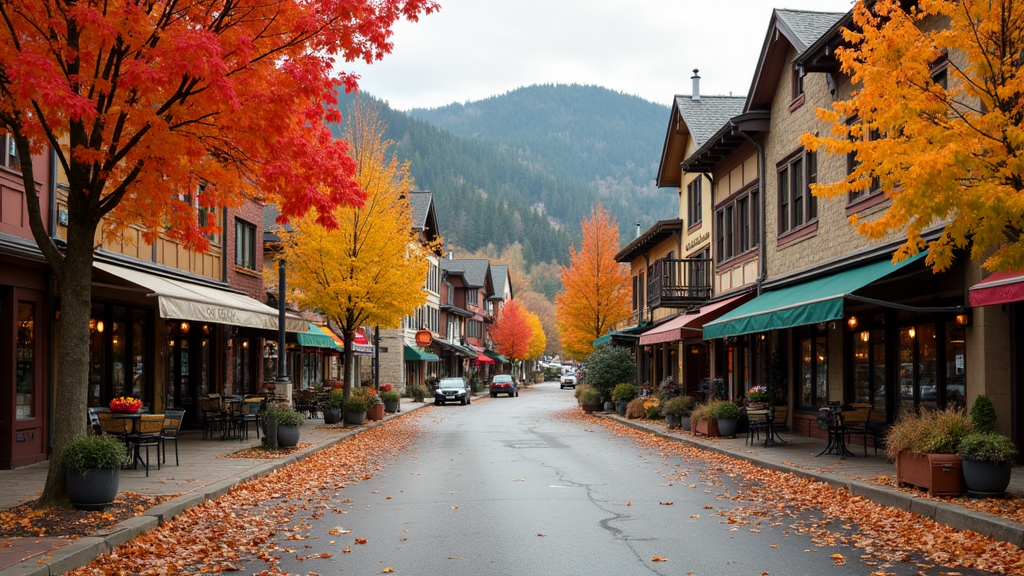
Gatlinburg is the ultimate kickoff spot for exploring the fall wonders of the Great Smoky Mountains. Crowned as the top fall getaway spot, Gatlinburg is packed with fun things to do, tasty eats, and easy access to the Great Smoky Mountains National Park. You can lose yourself in Ripley’s Aquarium of the Smokies or take in the jaw-dropping views from the Gatlinburg Space Needle.
Stroll around town to discover charming shops, quaint cafes, and stunning views. Whether you’re wandering through the streets or hitting the great smoky mountains scenic drive, there’s a little something for everyone.
Prime Time for Leaf Peeping

Fall in the Smokies is a nature lover’s dream. The best time to see those stunning fall colors typically falls between mid-October and early November. As the leaves switch up their hues, the hills and valleys explode into a riot of reds, oranges, and yellows.
Perfect leaf-peeping weather happens when daytime temps are in the 70s and nights cool down to the 40s (Knox News). Higher spots like Clingmans Dome Trail get their fall groove on a couple of weeks before the lower valleys catch up.
| Elevation Location | Peak Foliage Time |
|---|---|
| High Spots (e.g., Clingmans Dome) | Early October |
| Mid Levels | Mid October |
| Low Lands (e.g., Knoxville) | Late October to Early November |
This means you can enjoy the fall colors for a good stretch of the season. Lower places like Knoxville and Oak Ridge pop with color from the last week of October into early November (Knox News). You’ll have plenty of chances to catch the stunning show.
Check out our smoky mountains visitor guide for the best spots and timing. Whether you’re hiking the popular trails or seeking out a secret vantage point, autumn in the Smokies will mesmerize and inspire. Don’t miss out on the magic of the season in this natural wonderland.
Fall Colors Delight
Heading to the Great Smoky Mountains in fall is a treat for your eyes. As the trees change, they turn the area into a dazzling wonderland.
When Colors Change
Everything starts changing color high up in the Smokies around mid-September. You’ll spot trees like yellow birch, American beech, mountain maple, hobblebush, and pin cherry showing off first. By October, the colors spread down to lower areas.
For the best views, check out Clingmans Dome Road, the Blue Ridge Parkway, or the Foothills Parkway. Typically, the leaves above 4,000 feet peak from early to mid-October. Cooler nights (in the 40s) and warm days (70s) really make those colors pop (Knox News).
Trees Showing Off
In the Smokies, around 100 species of trees put on this fantastic show. Most of these are deciduous; they drop their leaves each year, bursting into color before they do.
Here are some key players in this autumn display:
- Sugar Maple
- Scarlet Oak
- Sweetgum
- Red Maple
- Hickories
Planning a trip? Check out our smoky mountains visitor guide for tips and more info.
Why Leaves Change Colors
The magic happens because of what’s inside the leaves. As the days get shorter, trees slow down on making chlorophyll – that’s the stuff that makes leaves green. With less chlorophyll, other colors in the leaves start to show.
| Pigment | Color Produced |
|---|---|
| Carotenoids | Yellow and Orange |
| Anthocyanins | Red, Purple, and Blue |
Carotenoids, always there, turn leaves yellow and orange. Anthocyanins pop up as chlorophyll fades and cool nights mix with sunlight, giving us reds, purples, and blues.
Want to see more? Our guides on great smoky mountains scenic drives and great smoky mountains sightseeing are perfect for planning your autumn trip.
So, get ready for some breathtaking scenes at the Great Smoky Mountains National Park. You won’t want to miss the incredible colors and the sheer variety of trees showing off their fall outfits. It’s a sight worth seeing every year!
Savor the Splendor
Trails for Autumn Adventures

The Great Smoky Mountains National Park offers nearly 900 miles of hiking options, showing off the fiery hues of fall. Whether you’re a trail veteran or a total newbie, there’s something here for you.
- Sugarlands Valley Nature Trail: A short, easy trail with loads of fall colors.
- Middle Prong Trail: Great for those with a bit more experience, complete with waterfalls and stunning views.
- Little River Trail: A longer trek with breathtaking autumn landscapes.
These trails are perfect for diving into the autumn charm of the Smokies.
Sky-High Colors and Tree Walk
Anakeesta’s Canopy Walk gives you a sky-high view of autumn. It’s the longest tree-based bridge in North America, putting you right among the vibrant leaves. Plus, the Chondola ride to the mountain top offers jaw-dropping fall scenery (Smoky Mountains Visitor Guide). Don’t forget to spot those cheeky chipmunks and elusive black bears!
| Name | Feature |
|---|---|
| Anakeesta Canopy Walk | Longest tree-bridge around |
| Chondola | Killer mountain views |
Towers with a View
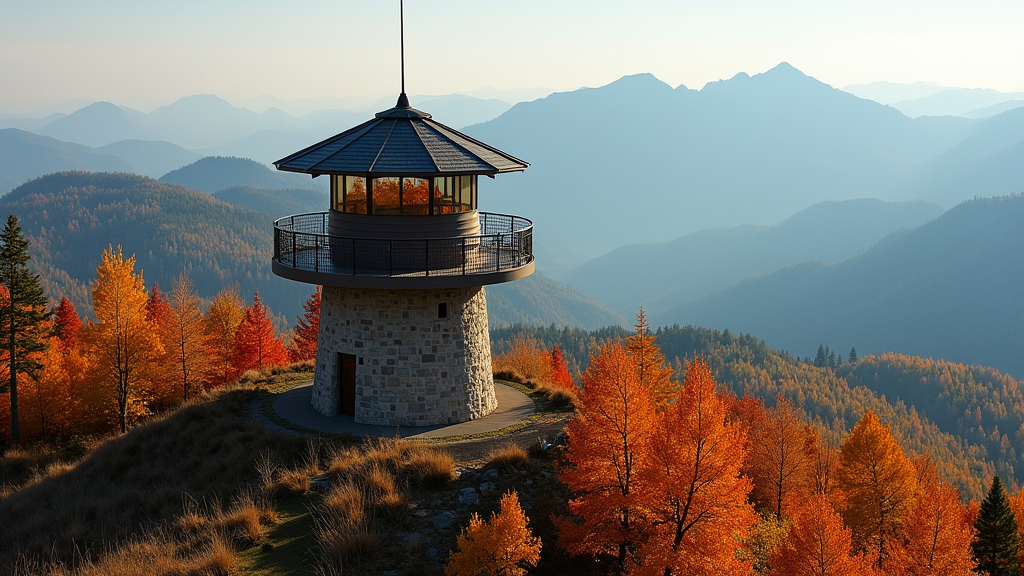
For those panoramic photo ops, check out Clingmans Dome Observation Tower and Look Rock Tower. Both spots offer 360-degree views of the Smokies and are particularly stunning at sunrise or sunset.
- Clingmans Dome Trail: A short hike takes you to the highest point in the park.
- Look Rock Tower: Found on the Foothills Parkway, it’s an easy walk with epic views.
Tram Rides and Horseback Adventures
Hop on the Aerial Tramway in Gatlinburg for a 2.1-mile ride up to Ober Mountain, climbing 1,472 feet. The tram offers unbeatable views of the fall foliage from the sky (Great Smoky Mountains Road Trip).
If you prefer to stay grounded, Cades Cove Riding Stables offers guided horseback rides. These trips let you bask in the fall scenery at a relaxed pace. No experience necessary, making it a hit for everyone (Great Smoky Mountains Horseback Riding).
| Activity | Experience |
|---|---|
| Aerial Tramway | Fall colors from above |
| Horseback Riding | Up-close autumn beauty |
Dive into the splendor of the Great Smoky Mountains this fall with these adventures. Find out more about plans for the perfect getaway in the Smokies.
Wildlife Encounters
Check out the Great Smoky Mountains in the fall! It’s an amazing time to spot all sorts of wildlife. Here’s a peek at some of the cool critters you might come across on your visit.
Black Bears in Action
With around 1600 black bears hanging out in the Great Smoky Mountains National Park, you’re in luck for a sighting. During autumn, these furry giants are on the move, getting ready for winter. Places like Cades Cove are prime spots to see them.
| Wildlife | Estimated Population | Common Areas |
|---|---|---|
| Black Bears | 1,600 | Cades Cove, lower elevations |
Speed Demons: Peregrine Falcons
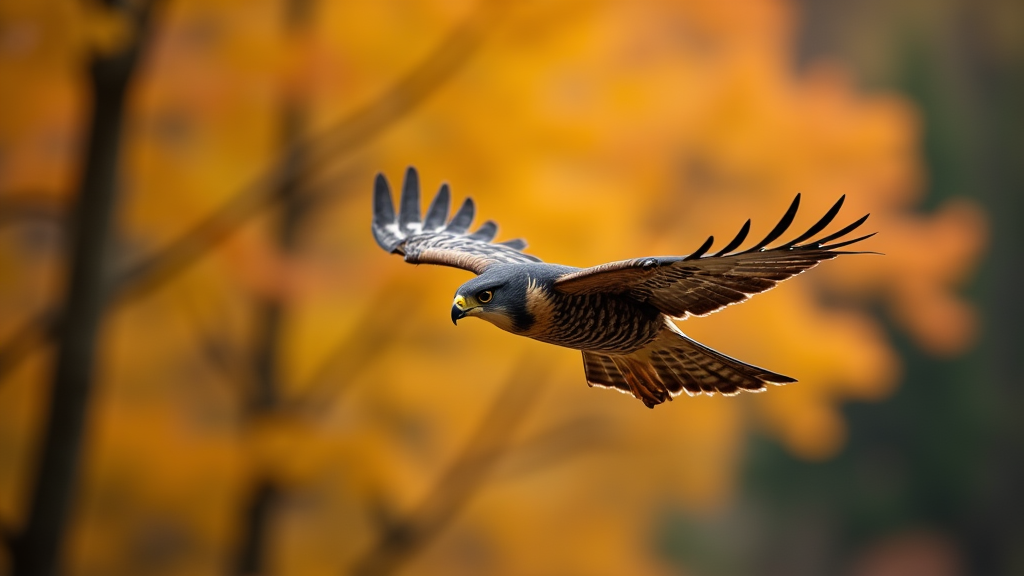
Peregrine Falcons set up shop on the rugged cliffs of Mt. LeConte. These speedsters can hit over 200 mph, making them a thrill to spot. They’re one of the few breeding pairs in Tennessee (Cabins USA Gatlinburg).
| Wildlife | Notable Behavior | Common Areas |
|---|---|---|
| Peregrine Falcons | Nesting, high-speed hunting | Mt. LeConte |
Splashing River Otters and Majestic Elk
Since their reintroduction in 1986, river otters have been loving life along Abrams Creek, Little River Trail, and Cataloochee Creek. The best otter-watching is at Abrams Creek near Cades Cove.
| Wildlife | Reintroduction Year | Common Areas |
|---|---|---|
| River Otters | 1986 | Abrams Creek, Little River Trail, Cataloochee Creek |
Want to see some elk? Around 150 elk were reintroduced to Cataloochee Valley in 2001. In the fall, bull elk show off their rutting skills, fighting for harems of cows (Cabins USA Gatlinburg).
| Wildlife | Reintroduction Year | Common Areas |
|---|---|---|
| Elk | 2001 | Cataloochee Valley |
Salamander Heaven

With about 30 different types of salamanders, the Great Smoky Mountains are rightly called the “Salamander Capital of the World.” These little guys are everywhere, even housing North America’s largest salamander, the Hellbender. You’ll find a rainbow of salamanders in the park’s streams.
| Wildlife | Species Count | Common Areas |
|---|---|---|
| Salamanders | ~30 species | Streams across the park |
Visiting the Great Smoky Mountains this fall is an adventure filled with incredible wildlife. For more on these amazing creatures, check out our great smoky mountains wildlife guide or plan an informative great smoky mountains road trip for a full park experience.
Trailblazing Delight: Best Hikes in Great Smoky Mountains National Park
Timing Your Visit
Best Time to See Stunning Fall Colors
You want to catch the Great Smoky Mountains at their most colorful? You’ve got to hit that sweet spot temperature-wise. Daytime temps hovering in the 70s and nights dipping into the 40s are what you’re after for the most vivid colors. This combo kicks off the chemical magic transforming leaves into a fiery display.
| Temperature | Day (°F) | Night (°F) |
|---|---|---|
| Perfect Range | 70s | 40s |
Where and When to Catch Peak Colors
The Smokies’ elevation shifts mean getting the timing right can be a bit tricky. Higher up, like around Clingman’s Dome, fall colors start showing off around mid-September. Down in the East Tennessee valleys, you’re looking at peak colors from mid-October to early November.
| Elevation | Peak Time |
|---|---|
| 4,000+ feet | Mid-September |
| Lower elevations | Mid-Oct to Nov |
For the prime fall views, stroll over to the observation towers and elevated viewpoints within the park.
Hidden Gems for Leaf Peeping
Steer clear of the tourist-packed spots and check out some less crowded but drop-dead gorgeous places to see those fall leaves. Try the [Cherohala Skyway] or the Big South Fork National River and Recreation Area for unique vantage points with way fewer people. You’ll get a peaceful, more personal leaf-peeping experience there.
Want more secret spots? Peek at our off-the-beaten-path suggestions to make your fall trip extra special.
And hey, don’t forget to carve out some time for a Great Smoky Mountains road trip to soak in all that autumn goodness the mountains are serving up.
Responsible Wildlife Viewing
When you’re lucky enough to visit the Great Smoky Mountains in the fall, you’ll be delighted by the variety of wildlife that calls this place home. But remember, it’s super important to watch these animals responsibly to keep both them and yourself safe.
Wildlife Activity and Viewing Tips
Knowing what the park’s animals are up to can make your trip even better:
- Black Bears: Busy getting ready for hibernation, especially in places like Cades Cove. Keep your eyes peeled!
- Peregrine Falcons: You might spot them nesting on the cliffs.
- River Otters: Often seen having a splash around the park’s rivers and streams.
Here are some top tips:
- Use binoculars, a spotting scope, or a camera with a good zoom to see animals from a safe distance.
- Walk quietly and be patient; it’s worth the wait to see animals doing their thing.
- Early mornings or late evenings are prime times for sightings.
What Not to Do with Wildlife
Following the rules is a must to keep everyone safe. Feeding, touching, teasing, or disturbing animals is a no-go. These actions can make animals behave unpredictably and be dangerous.
| Activity | Why it’s a Bad Idea |
|---|---|
| Feeding Wildlife | Makes them dependent on humans and often leads to them being put down |
| Approaching Wildlife | Interrupts their natural behaviors and can be harmful |
| Touching or Teasing | It’s illegal and can provoke aggressive reactions |
Messing with wildlife is not just wrong; it can get you fined or even arrested.
Keeping Safe and Protecting Nature
Watching out for your safety and nature’s beauty is something we can all do:
- Keep Your Distance: Stay at least 50 yards (150 feet) away, or enough that they don’t notice you.
- Stick to Paths: Stay on marked trails to avoid disturbing habitats.
- Trash: Pack it in, pack it out. Don’t leave any waste that could attract animals.
- Spread the Word: Tell others why responsible wildlife viewing is important.
For more pro tips, check our in-depth guide on great smoky mountains wildlife.
By following these tips and respecting park rules, you help keep the Great Smoky Mountains’ wildlife thriving. Your actions make a big difference, ensuring that this natural wonder stays amazing for generations to come.



